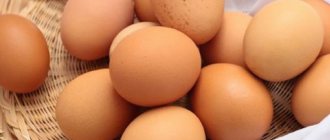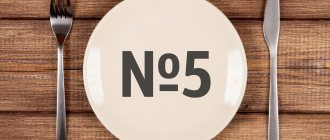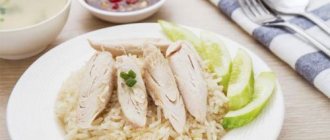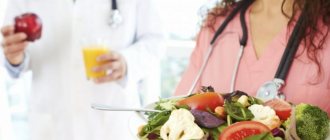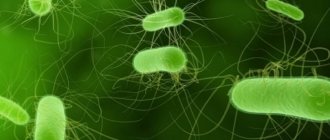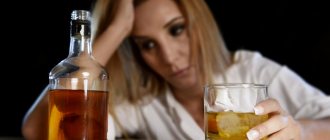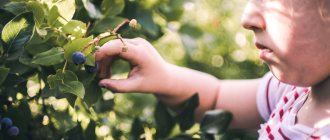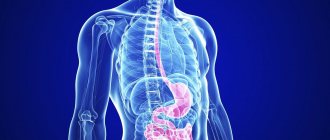Baby vomiting is usually very scary for parents. In most cases, there is nothing to be afraid of; vomiting is a mechanism developed by the body to protect itself from the introduction of toxic substances through the walls of the stomach and intestines. It can be one-time, or it can be repeated several times. In any case, even with minor such manifestations, you need to show the child to a specialist who will examine him, prescribe treatment, and give advice on what to feed the child after vomiting.
Features of the child's body
Feeding children should be taken seriously. Below are the main features of the child’s body that should be taken into account when creating a menu after poisoning.
- A child's body grows and develops very quickly and needs a complete daily supply of proteins, carbohydrates and fats. A child who is poisoned should not starve.
- The digestive system in young children is not fully developed. For faster absorption, it is advisable to chop or twist dietary foods.
- During preschool age, children's teeth begin to fall out. When feeding your baby, think about his ability to chew food thoroughly. Swallowed large pieces of food will irritate the gastric mucosa, which is inflamed after poisoning.
Remember that dietary nutrition in case of poisoning must be prescribed and described in detail by the treating pediatrician. It should take into account the characteristics of a particular organism and concomitant chronic diseases.
Water
Babies' immunity develops gradually - in the first months of life, their tiny body is especially vulnerable to germs and harmful substances. That is why it is best to start introducing a child to drinks with clean water at room temperature.
The easiest way is to use store-bought water - but keep in mind that the same water that you drink will not suit your baby. Look for bottles marked “baby”: this means that the water has passed all the necessary degrees of purification and has a low level of mineralization (the abundance of minerals harms the baby’s delicate kidneys). As a last resort, you can use boiled tap water, but only filtered water: your baby definitely does not need bleach and heavy metal salts.
What are the basic dietary rules for children?
What to feed a child after vomiting? Diet after food poisoning is a mandatory component of treatment. In its absence, any treatment of the baby will be ineffective. Below are the basic rules and recommendations for feeding a child after poisoning.
- Follow your diet. You need to eat often and in small portions. Children's nutritionists recommend eating a little food every 2-3 hours. The size of a baby's single serving should not exceed the size of his palm. This diet helps improve intestinal motility and regulate the functioning of the pancreas and liver.
- Prepare your child's meals in the oven, steamer, or boil. These cooking methods help retain the nutrients in the food. Food prepared using these dietary methods does not burden the digestive system and is easily digested.
- Provide your baby with separate meals. There is no need to mix protein and carbohydrate foods. For example, it is better to eat chicken and porridge separately from each other. Separate nutrition ensures easy digestion.
- Food and drinks should be at room temperature. Hot and cold irritates the mucous membrane of the esophagus and stomach, slowing down recovery.
Remember that in case of food poisoning, children are strictly prohibited from giving fried, smoked, spicy and fatty foods.
Features of the drinking regime
Drinking regimen is an integral part of the diet in case of poisoning. The child's body loses a large amount of fluid through vomiting and diarrhea. You can make up for these losses by drinking plenty of fluids. It is best to drink little and often. It is optimal to drink 1 tablespoon of liquid every 10 minutes.
Please note that in case of severe poisoning, with severe intoxication, dehydration of the child is treated in a hospital setting. The required amount of fluid is administered intravenously.
Drinks allowed for poisoning in children:
- non-carbonated mineral water with an alkaline pH, for example Borjomi;
- lightly sweetened black tea;
- dried fruits compote;
- table water.
In case of poisoning, it is forbidden to drink freshly squeezed or store-bought juices, strong tea, sour or carbonated drinks.
What can you eat on the first day of poisoning?
According to the new WHO protocols, you need to start feeding your child on the first day of food poisoning. Previously, it was believed that you need to fast for the first few days.
The diet after poisoning in children on the first day of the disease is strict. The list of foods that can be given to a child during this period is limited. It includes the following dishes:
- boiled rice or oatmeal with a slimy consistency;
- biscuits without any flavoring additives;
- toasted white bread.
"Not for children" drinks
There are drinks that children can easily do without, but sooner or later they become familiar with them. And a responsible parent needs to be prepared for this.
As mentioned above, tea can appear on a child’s menu no earlier than 2 years old, and only on the condition that it is weakly brewed and diluted with milk. Cocoa, which all children adore, is allowed from the age of 3. And no matter how much you want to pamper your baby, remember: this drink should not be given more than three times a week.
Coffee is absolutely prohibited: a child can only try it in adolescence. As for sweet soda, you need to remember: it contains a heavy dose of sugar and dyes, so your baby does not need to get acquainted with “magic bubbles”.
Allowed products on subsequent days
What to feed a child after poisoning? Dietary nutrition should be followed for at least a week after the development of foodborne toxic infection.
The following is what you can eat after the first day of poisoning:
- low-fat chicken broth prepared without spices from the sirloin. It can be eaten with toasted white bread;
- boiled lean chicken or turkey meat. For easier digestion, the meat can be twisted or blended in a blender;
- vegetable puree soup with potatoes, carrots and zucchini;
- rice and oatmeal porridge boiled in water;
- bananas are the only fruit that can be eaten fresh if poisoned;
- apples baked in the oven or microwave;
- You can start eating low-fat cottage cheese, kefir from 4-5 days;
- low-fat sea fish (stewed or baked in the oven);
- boiled eggs or steam omelette cooked in milk;
- boiled potatoes, carrots, zucchini and pumpkin.
Prohibited Products
The list of prohibited foods and dishes after food poisoning in children is very wide. It consists of food that negatively affects the digestive system and metabolic processes in the baby’s body.
In case of poisoning, the following foods are strictly prohibited for children:
- fatty meats and fish;
- hard cheese;
- sausages, frankfurters, sausages, bacon and lard;
- meat by-products (liver, kidneys, stomachs, tongue, brain, lungs);
- store-bought semi-finished products;
- chocolate;
- confectionery flour products, cakes, marmalade;
- all fried or smoked products;
- fresh berries, fruits and vegetables (except bananas);
- cocoa, coffee;
- mushrooms;
- pickled and canned foods;
- ketchup, sour cream, mayonnaise, hot spices;
- various candies, marshmallows;
- sweet carbonated drinks;
- pasta.
Recommendations for parents - how to avoid conditions manifested by vomiting in a child
The main principle of prevention, which helps to avoid serious diseases, is daily adherence to the rules of personal hygiene. Since vomiting is often a symptom of intestinal infections, preventive measures should be aimed at preventing pathogenic bacteria and viruses from entering the child’s body. After visiting various public places, you must wash your hands thoroughly with soap. It is also recommended to sanitize your hands during the day before eating and after visiting the toilet.
How to buy and choose products correctly
If a child develops food poisoning, you need to pay special attention to your food purchasing choices. Below we have compiled recommendations for you that will help you purchase safe and healthy food for your baby.
- Buy products only from certified outlets. Avoid spontaneous markets and kiosks. It is best to buy them in large supermarkets or official markets.
- Feel free to ask for invoices and product inspection results. Sellers are required to present these documents to buyers.
- Check the expiration date of products. Expired goods can lead to re-poisoning. Please note that you need to look at the factory production date. In stores, they sometimes paste it with a newer date.
- Pay attention to the appearance of the product. For example, bananas with damaged skins can be dangerous.
- Smell the meat when purchasing. Fresh, chemical-free meat does not smell of anything. But meat parts that are not fresh are treated in stores with formaldehyde or chlorine. A child's weakened body may react negatively to such stale meat treated with chemicals and may become poisoned again.
- Do not purchase frozen foods (meat, fish, vegetables). You have no way of knowing how many times they have been defrosted and re-frozen. Such food can be hazardous to health.
- Do not buy ready-made meals for your child in stores or restaurants. You can be confident in the quality and safety of food only if you select and prepare the products yourself.
Homemade or store bought?
Many mothers are convinced that there is nothing better for their baby than drinks made at home, and only lazy people buy ready-made juices and dairy products, but this is not so. It is impossible to be sure that fruits and berries for compote do not contain nitrates and pesticides, and that tap water is free of harmful impurities. Baby food products from reliable and proven brands - such as Agusha - undergo many checks before reaching the store shelf, so there is no doubt about their quality.
The technological aspect is also important: homemade juices are not sufficiently purified from pulp and are very concentrated and therefore can cause increased gas formation in the baby. And industrially produced clarified juices guarantee the absence of such problems.
An example of a nutrition menu for a child after poisoning
The table below shows an example of a daily food menu for a child after food poisoning.
| Eating | Food |
| Breakfast |
|
| Afternoon snack |
|
| Dinner |
|
| Snack |
|
| Dinner |
|
Between these meals you can have small snacks. The child should not feel hungry or overeat. You can use this menu as a guide when planning your child’s diet.
Juices
Despite the fact that juices are considered the richest source of vitamins, they should be introduced into the child’s menu with great caution and not earlier than 8 months. The thing is that they contain many allergens, and the baby’s delicate body should get acquainted with new drinks gradually.
You need to start with clarified juices, and from 10 to 11 months the child can be offered juices with pulp. As with the introduction of complementary foods, at first preference should be given to single-ingredient drinks (that is, from one fruit): this is done in order to exclude a specific product from the baby’s menu in case of an allergic reaction.
The first portion of juice should be very small - just a few drops. Then, every day increasing the dose by half a teaspoon, after a week you need to bring it to 30 ml (6 teaspoons). And by the end of the first year of life, the baby can safely drink 100 - 120 ml of the drink per day. At the same time, for children under 3 years old, it is better to dilute the juice with water in a 1:1 ratio.
There is also an optimal sequence of fruits for a baby: you should start with a green apple (it has the least allergens, but it has a lot of iron), then you can sequentially let the baby try pear, peach, apricot and plum juices. But it is better to postpone acquaintance with exotic fruits, strawberries, grapes and citrus fruits until the child is 1.5 years old.
Features of preparing chicken broth
You can feed your child chicken broth on the second day after poisoning. This dish helps replenish protein losses, restore strength and launch the motility of the digestive system. Nutritionists consider chicken broth an integral part of nutrition for foodborne illnesses.
This broth is made from chicken sirloin. This kind of meat is the most dietary and lean. You should eat the broth and the chicken meat from it separately.
Diet is an essential component of the treatment of poisoning in children. It is prescribed by the treating pediatrician. You need to stick to the diet for 1-2 weeks. All products should be easily digestible, cooked in a double boiler, oven or boiled. Your child needs to eat often and in small portions. On the first day of illness, you can only eat biscuits, dried white bread and rice porridge with a slimy consistency. In subsequent days, the diet expands.
